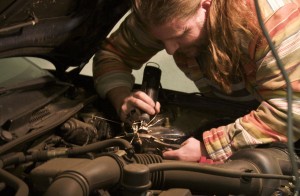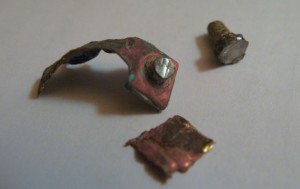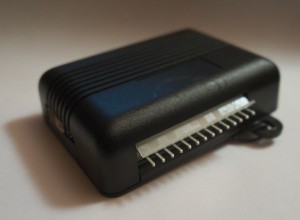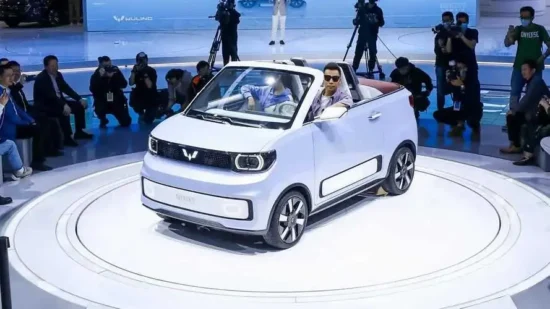Even the most reliable cars require occasional maintenance, like changing the battery. Happily, this is a very simple operation — unclamp, remove, replace, clamp, and away you go. Simple, right? Right? It’s not like it’s the kind of task that would take more than a week to accomplish.
A little more than a week ago I was working here in my office when my sweetie went out to run errands. The sound of the car starting wasn’t quite right, but she got it going and away she went. A couple hours later she called from her parents’ house. “My battery is dead. I’ll be home as soon as I get a jump start from Dad.”
The battery is the original that came with the car, ten years ago. Not terribly surprising that it needed replacing. (And it’s worth noting that this is the first trouble of any sort with the car.) I opened the hood to take a look-see. The negative terminal was badly corroded, along with some pieces that connected to it. The pair of nuts that clamped the connector onto the lead battery post were not really recognizable anymore. I realized it was going to be tricky to loosen them.
Although in the end it turns out there was no need; the clamp itself was cracked through. That explains the sudden loss of electricity, rather than a slow decay of battery performance. I would need a new battery terminal connector as well as a new battery.
I looked closer and realized that there were two parts connected to the old terminal – one a fairly typical heavy-gauge wire connected to the chassis nearby, as you will find in dang near every car, and another elbow-shaped copper piece that was fused into a plastic connector that had a pair of other plastic connectors snapped into it. A Dealer Part. The metal was badly corroded, and I thought it would be a good idea to replace that bit, too.
I tabled that thought, however, and ambled off to the local Kragen to get the new battery and a standard terminal connector. I brought them home and set to work loosening the nut that held all the pieces together.
I quickly realized that I didn’t have the tools to loosen a nut that has been corroded almost beyond recognition. Off I went to Sweetie’s Father’s house to borrow his socket set. Home again, to discover that the smaller sockets weren’t deep enough to get all the way down the shaft of the bolt and onto the nut. There were some box wrenches in the set, but they were all too big. I was faced with another decision. I judged that it was time I had a decent set of wrenches of my own, and so away once more I went, this time to the local Ace hardware.
After a long time considering options, it boiled down to two choices: a set of wrenches with both metric and SAE, or a set with a wider variety of SAE sizes. I didn’t think the metric-and-SAE set went small enough, so I went with the comprehensive SAE set (it also had a holder for storage, which in our current situation is a big plus).
Home once more with new wrenches (always good to have anyway), I dove back under the hood and discovered that Americans building cars in American plants are putting metric nuts in their cars now. While overall I’m behind this movement to get in sync with the rest of the world, I still didn’t have the right wrench. It was late, I was tired; I put some penetrating oil on the mess and resolved to finish with the car the next day.
The following day I took another trip to Ace and bought the metric version of the set of wrenches I’d bought the day before. I also bought a pair of vice-grips, in case things got ugly. Home again and back under the hood, things got ugly. The nuts were too corroded, and were chemically welded. The vice grips could lock on with mechanical ferocity, but the material of the nuts was not able to withstand the force necessary to unfreeze them.
During this operation I made another discovery. Normally the clamp that goes over the battery terminal is a separate piece that the ground wire bolts to. Not in this car. The broken metal strap was a contiguous piece crimped directly onto the ground wire. I figured I could work around that, but it was looking more and more like the other Dealer Part was not coming off the car intact. To the Internet I went.
There was no mention of a part like this on any Ford Web site. Finally in a Ford Escort owner’s group I found my answer: the part could only be obtained by buying an entire wiring harness for $350. Say what, now? Also the broken terminal strap that started this whole mess was only included in that $350 purchase.
We ruled out that option and I went back to unscrewing The Nuts That Were No Longer Nuts. Failure, fatigue, and another day lost ensued. That night I decided that bolt cutters were called for, but I wasn’t sure how to get them down into the recess where the nuts lay. Perhaps a little saw would be better. I called Father-of-Sweetie the next day and of course he had all those things. “Do you have a little Dremel tool?” I asked, suddenly realizing what the right tool for the job was.

Sparks fly as I cut through the reluctant bolt.
“
We have a Dremel tool,” my sweetie informed me. Hot dog! I opened up the case, and there was a little cutting-wheel attachment, smiling up at me. It looked like a light at the end of a tunnel. On a gloomy Tuesday afternoon (the car first failed the previous Thursday), I opened the hood once again and set to work cutting the bolt, while being careful not to harm the Irreplaceable Dealer Part (IDP) any further. Sparks flew! Get the camera!” I hollered to my sweetie. She took some great shots. Now I wish I’d gotten more pictures up to this point, like a time-lapse of the slow aggregation of more and more tools.
Success! After cutting through nut and bolt about two millimeters above the surface of the IDP and then slowly carving away at that, at last the bolt came free! Now all I had to do was cut back the main ground terminal so it could be mounted on the new terminal strap, slip on the IDP, and go have a beer.

bits and pieces of the old terminal connector
Only…
The place to connect the Irreplaceable Dealer Part to the new terminal connector wasn’t flat enough for the IDP to sit flush. It would have to do, I decided, and cranked down on it to get the best contact I could and forged ahead. Not very far ahead, as it turns out; I dropped one of the nuts for the new connector. It fell under the battery tray. Probes with a magnet were fruitless. Shaking the car didn’t free it. We couldn’t get to the damn nut. We were thwarted for another night.
I’d been thinking about using a good old-fashioned lead terminal connector anyway, rather than the steel one I’d first purchased, so while on another shopping mission we flew by Sears Automotive and got what I thought was exactly the ticket. We got home and I told my sweetie it would only be a few more minutes. Hah.
On with the lead connector, on with the… What the #$%$@#! The corroded and truncated connector at the end of the main ground wire didn’t fit over the terminal post. *sigh* I used a screwdriver, twisting it in the hole, to widen the opening until I could just get it over the terminal. I was worried about that connector, though, corroded and abused as it was. I managed to get the IDP onto the clamping screw, and tightened everything down.
At last, the battery was installed.
I got in and the hazard lights blinked and the chime went “beep-beep… beep-beep” which I took as a sign that a) there was electricity, and b) the car was trying to tell us something. Like, that it had lost power and its electronics needed to readjust. I turned the key.
Nothing. Not even a click.
Well, crap. Back under the hood I went. Primary suspect: The used and abused ground connector. I cut the ground wire and stripped back the insulation. Holey moley – the copper was corroded right on up the wire, beneath the insulation. Powdery light-blue copper oxide fell like snow. I cleaned off what I could and clamped on a new connector that had come with the first terminal connector kit. I used parts from both kits to get the IDP bolted on with good contact as well. This was about as good as it was going to get without replacing the entire wiring harness. Key in ignition, lights came on, beepers beeped. I turned the key. Nothing. Not even a click.
Perhaps the battery didn’t have enough charge to turn over the starter. The Miata was standing nearby, so my sweetie and I pushed the Escort out into the gentle rain to the other end of the carport. We hooked up the jumper cables (using an entirely different ground point), waited a couple of minutes, then turned the key. I think you can guess what happened. Yep, lights flash, beeper beeps, turn the key and nothing — that’s what happened. We pushed the car back, managing the slight uphill better than I thought we would, and I turned once more to the Internet.
After striking out finding any sort of answer myself, I found JustAsk.com, a place where, for a fee, I could ask a certified Ford mechanic what the heck was going on. I went through the preliminary steps, plunked down fifteen bucks, and asked my question to a guy named Chuck.
“Is it a dealer or aftermarket anti-theft device?” he asked.
“I specifically told the dealer I didn’t want any of that,” my sweetie said when I relayed the question.
“Well, you have one,” Chuck informed us. “You need to find the reset button.”

The anti-theft module we didn't want
Long story (that had me contorting myself underneath the dashboard) short, we did have an anti-theft device, and it didn’t have a reset button. That was the part that the dealer was trying to sell my sweetie when she declined to be upsold.
To emphasize: Frontier Ford of San Jose sold my sweetie a car that would become completely disabled any time the battery was disconnected. What if she’d been out in the middle of nowhere when something happened to interrupt the electricity? What else might have activated the device? The irresponsibility of the dealer is simply mind-boggling. There really are no words to express the depth and breadth of my anger, and it pales next to the world-class ire my sweetie felt.
After a couple of hours tracing wires, we called it a night. At least we knew the problem. I would be able to remove the module, but I needed wire and connectors to restore wires that the anti-theft module interrupted. The next day I went out to the car again and got my only pleasant surprise of this whole endeavor: merely removing the plastic anti-theft module but leaving all the wiring in there actually allowed the car to start again. I’m a little surprised at this outcome, but I’m not questioning it.
When she heard her car start, my sweetie came down and hugged me and congratulated me on getting the damn thing fixed. Honestly, though, when you consider I made six trips, bought wrenches, vise-grips, multiple redundant parts, had my sweetie pushing a car in the rain, and torqued my back, all to change a battery, it doesn’t sound so great. But there it is.
 3
3
Sharing improves humanity:








 The breakfast was excellent. The eggs were cooked right, the chile was good, and the service continues to be outstanding. Breakfast done, green chile afterglow warming the base of my brain, fresh tea bags with refills of hot water, it was all good. I started to write about my morning. I had just typed “OK” above when the manager (owner? he doesn’t look much like an Anita) asked if I was getting good wireless reception where I was sitting. It turns out he had just installed the system and hadn’t advertised it yet because he wanted to make sure it worked well first.
The breakfast was excellent. The eggs were cooked right, the chile was good, and the service continues to be outstanding. Breakfast done, green chile afterglow warming the base of my brain, fresh tea bags with refills of hot water, it was all good. I started to write about my morning. I had just typed “OK” above when the manager (owner? he doesn’t look much like an Anita) asked if I was getting good wireless reception where I was sitting. It turns out he had just installed the system and hadn’t advertised it yet because he wanted to make sure it worked well first.